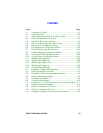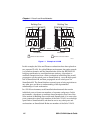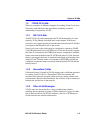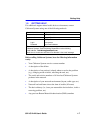
Chapter 1:
Virtual Local Area Networks
1-4 802.1Q VLAN User’s Guide
1.3 BENEFITS AND RESTRICTIONS
The primary benefit of the 802.1Q VLAN technology is that it provides
localization of traffic. This function also offers improvements in security
and performance to stations assigned to a VLAN.
While the localization of traffic to VLANs can improve security and
performance, it imposes some restrictions on network devices that
participate in the VLAN. Through the use of Filtering Database ID’s
(FIDs) security can be implemented to enable or prevent users from one
or more VLANs from communicating with each other.
One or more VLANs can be assigned to a FID so that all the users that
share a common FID can communicate with each other regardless of their
VLAN affiliation. However, for the sake of security, the members of one
FID cannot communicate with the members of another FID.
To set up a VLAN, all the network switch devices that are assigned to the
VLAN must support the IEEE 802.1Q specification for VLANs. Before
you attempt to implement a VLAN strategy, ensure that the switches
under consideration support the IEEE 802.1Q specification.
1.4 VLAN TERMS
To fully understand the operation and configuration of port based VLANs,
it is essential to understand the definitions of several key terms.
VLAN ID
A unique number (between 1 and 4094) that identifies a particular VLAN.
VLAN Name
A 32-character alphanumeric name associated with a VLAN ID. The
VLAN Name is intended to make user-defined VLANs easier to identify
and remember.
Filtering Database Identifier (FID)
Addressing information that the device learns about a VLAN is stored in
the filtering database assigned to that VLAN. Several VLANs can be
assigned to the same FID to allow those VLANs to share addressing
information. This enables the devices in the different VLANs to
communicate with each other when the individual ports have been
configured to allow communication to occur.


















